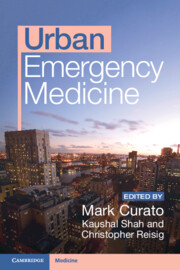Book contents
- Urban Emergency Medicine
- Urban Emergency Medicine
- Copyright page
- Contents
- Contributors
- Preface
- Chapter 1 Caring for the Homeless
- Chapter 2 Disruptive and Dangerous Agitation
- Chapter 3 Penetrating Trauma
- Chapter 4 Substance Use
- Chapter 5 Human Trafficking
- Chapter 6 Travelers from Overseas
- Chapter 7 HIV, AIDS, and Tuberculosis
- Chapter 8 Asthma
- Chapter 9 Physician/Patient Discordance
- Chapter 10 LGBTQIA+ Care
- Chapter 11 Child Maltreatment
- Chapter 12 Care of Vulnerable Elders
- Chapter 13 Civil Unrest: Caring for Police and Protesters
- Chapter 14 Terrorism and Mass Casualty Incidents
- Chapter 15 Overcrowding, Triage, and Care Rationing
- Index
- References
Chapter 2 - Disruptive and Dangerous Agitation
Published online by Cambridge University Press: 20 July 2023
- Urban Emergency Medicine
- Urban Emergency Medicine
- Copyright page
- Contents
- Contributors
- Preface
- Chapter 1 Caring for the Homeless
- Chapter 2 Disruptive and Dangerous Agitation
- Chapter 3 Penetrating Trauma
- Chapter 4 Substance Use
- Chapter 5 Human Trafficking
- Chapter 6 Travelers from Overseas
- Chapter 7 HIV, AIDS, and Tuberculosis
- Chapter 8 Asthma
- Chapter 9 Physician/Patient Discordance
- Chapter 10 LGBTQIA+ Care
- Chapter 11 Child Maltreatment
- Chapter 12 Care of Vulnerable Elders
- Chapter 13 Civil Unrest: Caring for Police and Protesters
- Chapter 14 Terrorism and Mass Casualty Incidents
- Chapter 15 Overcrowding, Triage, and Care Rationing
- Index
- References
Summary
Agitation is a cardinal emergency medicine and prehospital presentation and occurs across a spectrum of severity and risk. Moderately agitated patients can be adequately assessed to exclude dangerous conditions, and if verbal de-escalation fails, may be treated with small doses of a titratable sedative or combination of sedatives, repeated as needed to calm the patient. Dangerously severe agitation is an uncommon medical emergency requiring prompt recognition and treatment in a high-resource care setting. Management focuses on the immediate treatment of agitation so that the patient and others are protected from uncontrolled violence, and so that dangerous causes and effects of agitation are quickly identified and addressed. Once adequate personnel are assembled to safely approach and subdue the patient, face mask oxygen is applied and dangerous restraint holds are relieved. Maximally effective calming medications are administered intramuscularly to quickly treat agitation. As the patient calms, resuscitation-level monitoring and care proceeds, with particular attention to ventilation, as the range of immediately dangerous causes and consequences of agitation are addressed.
Keywords
- Type
- Chapter
- Information
- Urban Emergency Medicine , pp. 13 - 25Publisher: Cambridge University PressPrint publication year: 2023

